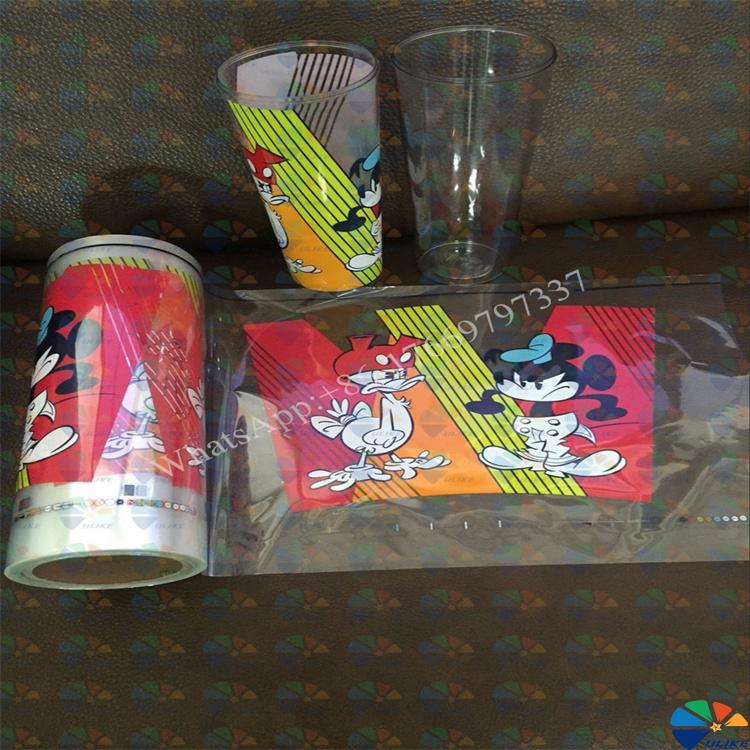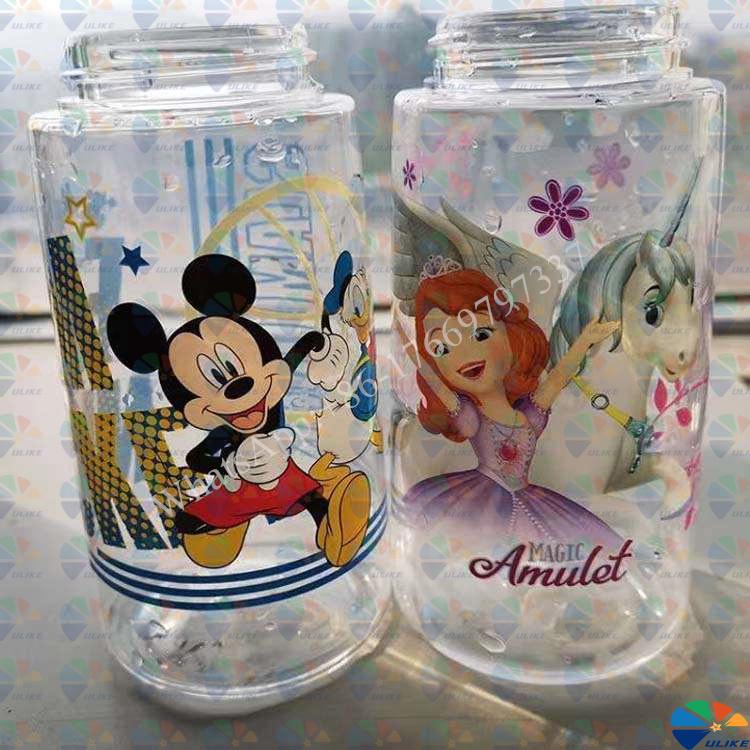Application of thermal transfer on glass bottles
Application of
thermal transfer on glass bottles
Thermal transfer film is a technical method of printing patterns and glue on heat-resistant films, and adhering patterns (ink layers) and glue layers to glass bottles through heating and pressure. This process is mostly used on plastics and paper, and is less used on glass bottles.

Process flow: 1. Color draft; 2.
Printing film; 3.
Thermal transfer; 4. Baking.
Thermal transfer film is generally divided into five layers, with the surface PET film layer as the carrier and the separation layer as the heat-resistant layer. The protective layer protects the ink layer, the ink layer is the pattern printing, and the adhesive layer is the adhesion layer.
Since the multi-color pattern can be drawn at one time during the film printing stage, the existing pattern can be transferred to the glass bottle at one time during the transfer operation on the glass bottle. Compared with the cumbersome positioning of multi-color silk screen printing, it can greatly shorten the work of printing and reduce the material loss caused by printing errors. Nowadays, labor costs are rising, and customers have high quality requirements for accurate positioning, so the advantages of thermal transfer are very obvious in multi-color drafts.
In addition, in the film printing stage, CMYK printing is traditionally used, and spot color printing can also be performed according to customer requirements. The effect of thermal transfer is more realistic, with high color reproduction, and gradient color can be achieved. Due to the heat baking of the image, the color of the finished image will be more solid than that of water transfer, and it is not easy to fade. It has good properties such as corrosion resistance, aging resistance, wear resistance, and high temperature resistance.
In glass bottle processing, compared with water transfer and screen printing, thermal transfer has obvious advantages.
In general, compared with traditional water transfer and screen printing, thermal transfer has the advantages of: less manpower consumption, high degree of automation, fast, accurate color registration, high yield, and less environmental pollution. However, the disadvantage of thermal transfer is that it has high requirements for the standardization of the substrate and needs to be operated in a more regular position. Square bottles and cylindrical bottles are very advantageous for processing. Special-shaped bottles need to be analyzed according to the entity to confirm the processable position. In the development of thermal transfer, in addition to ordinary toner inks, many new types have been developed, such as pearl ink film, mirror ink thermal transfer film, and thermal transfer film with hot stamping. Looking forward to the future, thermal transfer on glass bottles will be more widely used.

![af]() Afrikaans
Afrikaans![sq]() Albanian
Albanian![am]() Amharic
Amharic![ar]() Arabic
Arabic![fr]() French
French![es]() Spanish
Spanish![ru]() Russian
Russian![de]() German
German![hy]() Armenian
Armenian![it]() Italian
Italian![ja]() Japanese
Japanese![ko]() Korean
Korean![pt]() Portuguese
Portuguese![hi]() Hindi
Hindi![az]() Azerbaijani
Azerbaijani![ro]() Romanian
Romanian![pl]() Polish
Polish![th]() Thai
Thai![el]() Greek
Greek![eu]() Basque
Basque![en]() English
English![zh-CN]() Chinese (Simplified)
Chinese (Simplified)![zh-TW]() Chinese (Traditional)
Chinese (Traditional)![be]() Belarusian
Belarusian![bn]() Bengali
Bengali![bs]() Bosnian
Bosnian![bg]() Bulgarian
Bulgarian![ca]() Catalan
Catalan![ceb]() Cebuano
Cebuano![ny]() Chichewa
Chichewa![co]() Corsican
Corsican![hr]() Croatian
Croatian![cs]() Czech
Czech![da]() Danish
Danish![nl]() Dutch
Dutch![eo]() Esperanto
Esperanto![et]() Estonian
Estonian![tl]() Filipino
Filipino![fi]() Finnish
Finnish![fy]() Frisian
Frisian![gl]() Galician
Galician![ka]() Georgian
Georgian![gu]() Gujarati
Gujarati![ht]() Haitian Creole
Haitian Creole![ha]() Hausa
Hausa![haw]() Hawaiian
Hawaiian![iw]() Hebrew
Hebrew![hmn]() Hmong
Hmong![hu]() Hungarian
Hungarian![is]() Icelandic
Icelandic![ig]() Igbo
Igbo![id]() Indonesian
Indonesian![ga]() Irish
Irish![jw]() Javanese
Javanese![kn]() Kannada
Kannada![kk]() Kazakh
Kazakh![km]() Khmer
Khmer![ku]() Kurdish (Kurmanji)
Kurdish (Kurmanji)![ky]() Kyrgyz
Kyrgyz![lo]() Lao
Lao![la]() Latin
Latin![lv]() Latvian
Latvian![lt]() Lithuanian
Lithuanian![lb]() Luxembourgish
Luxembourgish![mk]() Macedonian
Macedonian![mg]() Malagasy
Malagasy![ms]() Malay
Malay![ml]() Malayalam
Malayalam![mt]() Maltese
Maltese![mi]() Maori
Maori![mr]() Marathi
Marathi![mn]() Mongolian
Mongolian![my]() Myanmar (Burmese)
Myanmar (Burmese)![ne]() Nepali
Nepali![no]() Norwegian
Norwegian![ps]() Pashto
Pashto![fa]() Persian
Persian![pa]() Punjabi
Punjabi![sm]() Samoan
Samoan![gd]() Scottish Gaelic
Scottish Gaelic![sr]() Serbian
Serbian![st]() Sesotho
Sesotho![sn]() Shona
Shona![sd]() Sindhi
Sindhi![si]() Sinhala
Sinhala![sk]() Slovak
Slovak![sl]() Slovenian
Slovenian![so]() Somali
Somali![su]() Sudanese
Sudanese![sw]() Swahili
Swahili![sv]() Swedish
Swedish![tg]() Tajik
Tajik![ta]() Tamil
Tamil![te]() Telugu
Telugu![tr]() Turkish
Turkish![uk]() Ukrainian
Ukrainian![ur]() Urdu
Urdu![uz]() Uzbek
Uzbek![vi]() Vietnamese
Vietnamese![cy]() Welsh
Welsh![xh]() Xhosa
Xhosa![yi]() Yiddish
Yiddish![yo]() Yoruba
Yoruba![zu]() Zulu
Zulu



